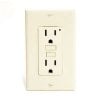Hello. I posted this a few days ago and after trying to find it again this morning, it apparently didn't exist.
Anyway, I'm running a 1000 watt light/ballast (with no timer yet) . Since I was running it for 24 hours, I can understand the stress. After about 2 weeks I pulled the plug and smelled plastic, and saw meltedness.
Now in my last apartment, which was much newer and nicer, I ran the same ballast (only with HPS) and ran them for only twelve hours a day. It took about 4 to 5 months for that socket to start melting as well. That time I was using an intermatic digital timer, and also had my 8" fan plugged into the same timer. I figured that was the problem (having them both plugged in), but as it turns out the ballast can melt the socket on its own.
So currently I went back to 12 from 24, and put it back into its timer, WITHOUT the fan, and so far no meltyness (Although its only been a couple days).
Any help or suggestions? Thanks for your time!
Anyway, I'm running a 1000 watt light/ballast (with no timer yet) . Since I was running it for 24 hours, I can understand the stress. After about 2 weeks I pulled the plug and smelled plastic, and saw meltedness.
Now in my last apartment, which was much newer and nicer, I ran the same ballast (only with HPS) and ran them for only twelve hours a day. It took about 4 to 5 months for that socket to start melting as well. That time I was using an intermatic digital timer, and also had my 8" fan plugged into the same timer. I figured that was the problem (having them both plugged in), but as it turns out the ballast can melt the socket on its own.
So currently I went back to 12 from 24, and put it back into its timer, WITHOUT the fan, and so far no meltyness (Although its only been a couple days).
Any help or suggestions? Thanks for your time!

